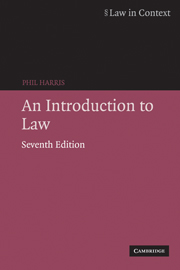Book contents
- Frontmatter
- Contents
- Preface
- Table of statutes
- Table of cases
- 1 Law and society
- 2 Law and morality
- 3 Law and the regulation of economic activity
- 4 Some important legal concepts
- 5 Law and property
- 6 Law and the settlement of disputes
- 7 The making of legal rules
- 8 The European dimension of English law
- 9 Liability in English law: the law of tort
- 10 Liability in English law: crime and the criminal justice system
- 11 The development and the role of the contract
- 12 Law and government
- 13 The legal profession
- 14 The judges
- Index
6 - Law and the settlement of disputes
- Frontmatter
- Contents
- Preface
- Table of statutes
- Table of cases
- 1 Law and society
- 2 Law and morality
- 3 Law and the regulation of economic activity
- 4 Some important legal concepts
- 5 Law and property
- 6 Law and the settlement of disputes
- 7 The making of legal rules
- 8 The European dimension of English law
- 9 Liability in English law: the law of tort
- 10 Liability in English law: crime and the criminal justice system
- 11 The development and the role of the contract
- 12 Law and government
- 13 The legal profession
- 14 The judges
- Index
Summary
Every social group contains within it the elements and conditions in which disputes will arise. Even the smallest social group will experience disputes between its members, and, as we would expect, the larger and more complex a social group becomes, the more varied and, perhaps, frequent will be the disputes which crop up within it. Hardly a day goes by in people's everyday lives without some problem occurring, some argument arising or some resentment or frustration being felt by one person or group over the activities of another. Family rows, arguments with friends, confrontations at work and so on are familiar to most people, as are the various solutions which we use to deal with those disputes.
The simplest disputes are dealt with by various informal, often quite good-natured, means. Within family units, there may be an invocation of an established family custom or rule, or the calling-in of a third party to mediate in the dispute. Rarely would family squabbles result in the initiation of any kind of formal proceedings to settle the matter. Similarly, the social and economic world outside such small units as friends or family rests upon various types of relationships between, for example, business enterprises, employers and employees, traders and consumers, and citizens and government agencies. When considering the frequency with which something goes wrong with the smooth running of these relationships, and a dispute arises, it is important to appreciate that the informal resolution of the problem, through concession or compromise, is by far the most usual way of settling the matter.
- Type
- Chapter
- Information
- An Introduction to Law , pp. 150 - 189Publisher: Cambridge University PressPrint publication year: 2006



